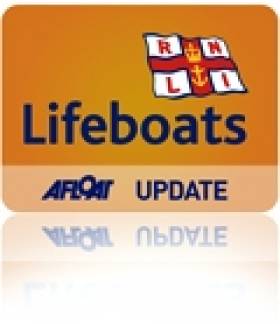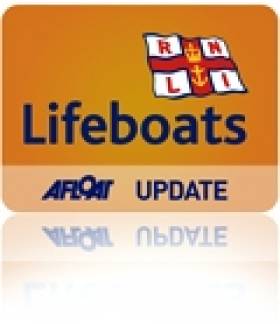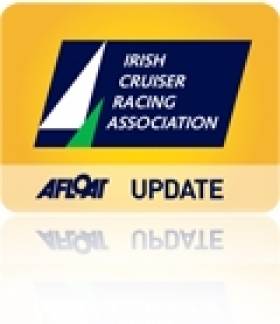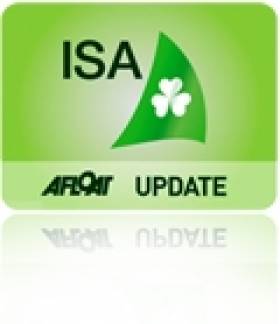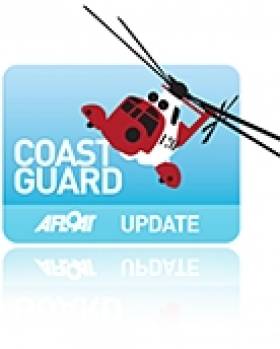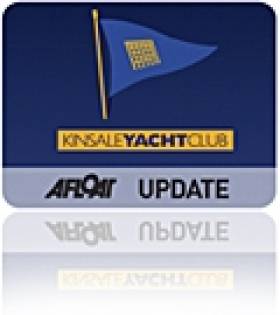Displaying items by tag: Cork Harbour
Crosshaven Lifeboat Rescues Crew from Sinking Fishing Vessel
At 11.19am , Valentia Coast Guard alerted Crosshaven RNLI Lifeboat that the fishing vessel was in serious trouble off the Church Bay area and requested an immediate launch. Crosshaven lifeboat launched within 5 minutes and with its volunteer crew of Kieran Coniry, Dan O'Donoghue and Vincent Fleming, made good progress through a two metre sea swell arriving on scene to find the fishing boat had at this stage sank and the crew safely in the Liferaft.
The Ballycotton RNLI all weather Lifeboat was at sea on exercise at the time and immediately altered course to the incident. Crosshaven Coast Guard were also tasked and en route.
When it became clear that the two crewmen were safely aboard the Crosshaven Lifeboat, the other emergency services were stood down. Crosshaven Lifeboat then brought the two fishermen back to Crosshaven.
While it is unknown what caused the fishing boat to flounder, the crew had little time to deploy their liferaft and make an emergency call before the boat sank.
Related Safety posts
RNLI Lifeboats in Ireland
Safety News
Rescue News from RNLI Lifeboats in Ireland
Coast Guard News from Ireland
Water Safety News from Ireland
Marine Casualty Investigation Board News
Marine Warnings
Lifeboat Assists Sinking Fishing Vessel in Cork Harbour
Yesterday while out on exercise in a squally southwesterly force four winds the crew of the Ballycotton lifeboat Austin Lidbury received details of a 26 foot fishing vessel that had sunk off Roches Point, at the mouth of Cork Harbour. The two crew members had taken to a liferaft and were retrieved by a fishing vessel in the area. Crosshaven lifeboat also launched and was first on scene. Ballycotton lifeboat was stood down and returned to station.
Related Safety posts
RNLI Lifeboats in Ireland
Safety News
Rescue News from RNLI Lifeboats in Ireland
Coast Guard News from Ireland
Water Safety News from Ireland
Marine Casualty Investigation Board News
Marine Warnings
Commodores' Cup Boats Jointly Awarded Boat of the Year Award
There was a strong seal of approval from sailing delegates at the ICRA Conference yesterday evening for the decision to award the Boat of the Year prize to all three Royal Cork boats from the winning Irish Commodore's Cup team.
Antix, Marinerscove and Roxy lifted the trophy to loud applause at the Carrigaline Court Hotel, the venue for ther eighth annual meeting of Irish Cruiser Racer interests. Last night Commodores Cup celebrations continued at the Royal Cork Yacht Club at a special dinner in honour of the team who brought home the cup after more than a decade of attempts.
In announcing their decision the ICRA judging team stated that as there was 'no way they could split the RCC boats that made up the winning team' this summer. The decision had been expected given the importance of the international victory in Cowes.
Earlier this month a readers poll on Afloat.ie that attracted nearly 3,000 votes showed an offshore yacht Raging Bull from Skerries to be a popular choice for the trophy. HERE. Discussion HERE. It's an indication of the widening appeal of a part of the sport that has been rekindled on the Irish Sea.

ICRA's Boats of the Year: The Cork team that won the Commodore's Cup. Montage by Bob Bateman
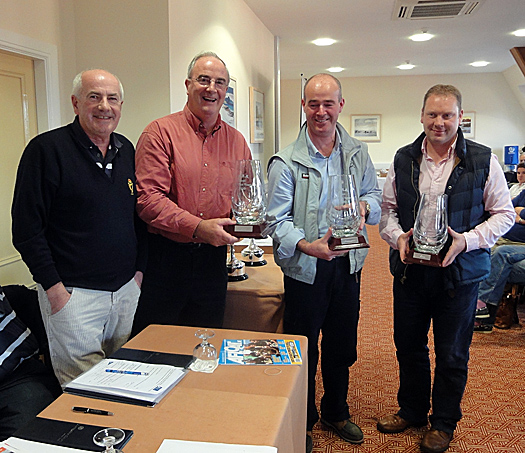
Winning Trio: ICRA Commodore Barry Rose (left) with skippers Anthony O'Leary, Dave Dwyer and Andrew Creighton. Photo by Peter Ryan
Poll Shows Raging Bull as Favourite for ICRA's Boat of the Year
With just 24 hours to go to the announcement of sailing's boat of the year award at tomorrow's Cork harbour ICRA conference the consistent poll topper from Afloat's online survey shows ISORA offshore champion Raging Bull as a clear favourite with 1175 votes. Second is Marinerscove on 873 and Errislannan third on 256 votes. Polling began just over a month ago and 2,600 votes have been cast. See the poll on the left hand column of the home page. There's still time to cast your vote to try and influence ICRA judges!
All Ireland Champs Move to Kinsale
The re-run of the All Ireland Sailing Championships will take place in Kinsale and not Crosshaven on November 20th according to a press release from the Irish Sailing Association published today.
A minimum of three races must be completed for the competition to conclude and the ISA Helmsman's Trophy awarded.
The final, originally scheduled to take place in Royal Cork Yacht Club on the 26th of September, had to be abandoned due to an absence of wind.
The competition will be sailed in the ISA SailFleet J80's which are currently based in Kinsale Yacht Club. Due to the difficulty in safely sailing the fleet from Kinsale to Crosshaven the venue had to be changed, however the host club remains Royal Cork Yacht Club who are now kindly assisted by Kinsale Yacht Club.
8 teams will be competing for the ISA Helmsmans Trophy. As this competition is recognised as a new event, no previous points shall be carried forward. Each competitor begins with a blank score card.
The finalists are:
Anthony O'Leary
Ewen Barry
Garrett May
James Espey
Neil Kenefick
Niall Henry
Nicholas O'Leary
Nick Walsh
Who'll win? We're starting a readers poll on Monday. Click back to cast your vote!
Coast Guard Urges Public Not to Go Out on Exposed Piers
The Irish Coast Guard service today issued an important warning to the public about high winds, gales and flooded areas. This warning comes following a weather warning and a strong gale warning issued by Met Eireann today. Southwest winds veering westerly will strengthen during this afternoon with stormy conditions becoming widespread.
Speaking today, Chris Reynolds Director of the Coast Guard said: "The public is strongly advised not to go out on exposed coasts, cliffs, piers, harbour walls, beaches, promenades or any other coastal areas. The principal dangers from this weather system will be due to gusts of 100 to 140 km/hr expected with the most severe in exposed parts of Ulster and Connacht. Showers will be heavy and thundery at times merging to give longer spells of rain in the north. Highest temperatures 9 to 11 degrees. Huge waves can be whipped up by high seas. These waves can pose hazards to anyone close to the shoreline. In coastal waters, rough seas are often the cause for capsizing fishing vessels. Some of these accidents can take place so quickly that there is no time for the crew to send out distress signals."
He continued: "Do not attempt to cross at fast running river or flood water fords as they may be stronger and deeper than you think. Flooded urban areas may contain many hazards, not least of which include submerged open manholes and downed power lines. The combination of tides, forecasted gale warnings for the next day or so, high sea conditions and swollen rivers may result in very dangerous conditions. Remember to monitor weather broadcasts when travelling and heed the advice of the RSA on road use during severe weather and high winds ."
Specific advice from the Coast Guard today is:
· Stay away from the shoreline and do not engage in water sports;
· Owners of small vessels and fishing vessels in coastal waters should seek shelterand secure them properly with moorings;
· Ships in the open sea should take heeds of weather forecasts and warnings and avoid the sea area with the most treacherous conditions.
Mr. Reynolds ended by saying: "If you do see someone in difficulty in the sea, on the shore, cliffs, lakes or rivers dial 999 or 112 and ask for the Coast Guard. "
Calves Week 2011 Notice of Race and Entry form Published
French Van Promotes Great Week of Irish Sailing
It's a great looking team sailing van, a brilliant advert for Irish sailing and an amazing photo of a TP52, planing like a dinghy in Cork harbour! The French Paprec Recylage Sailing Team have had their entire sailing van decorated with a dramatic Bob Bateman picture from Cork week 2010. The photos of the event HERE were a highlight of the 2010 season.
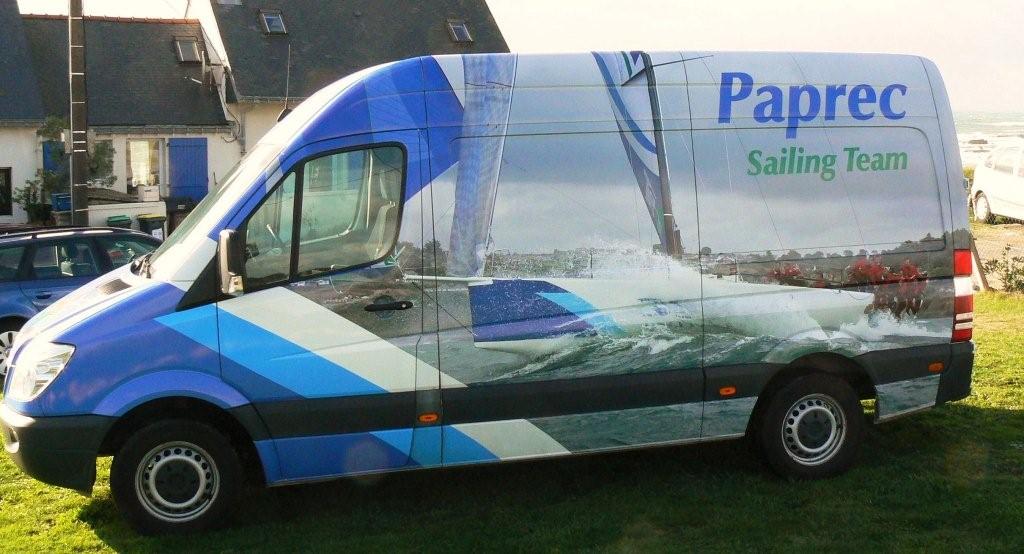
Castlepoint Boatyard
Castlepoint Boatyard is based in Crosshaven, Co. Cork, it offers the following services...
25 Tonne Travel Hoist
• Wood and GRP Repairs
• Respray, Coppercoat and
• Osmosis Treatments
• Bow Thruster and Heating
• Agents for Mermaid Diesel Engines
• Winter Storage
• Maintenance and insurance work
New 25 Tonne Travel Hoist
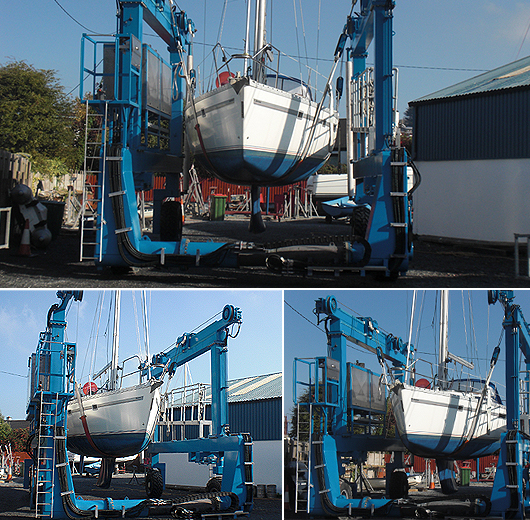
Crosshaven,
Co. Cork
Tel: 021 4832154
Email: [email protected]
Quarter Ton Class Returns to Sovereigns Cup
The Quarter ton fleet is sailing back to the Sovereigns Cup in 2011. The event runs in Kinsale from June 22-25th.
The Quarter ton fleet made its debut at the 2009 event where a total of seventeen boats competed for the 'Keane's Jewellers perpetual Quarter Ton trophy'. Boats travelled from all over Ireland for the event with seven boats making the journey from the UK.
The four-day regatta was sailed on windward leeward courses, with one coastal race along the beautiful West Cork coastline. The coastal race proved memorable as the fleet short tacked their way along the shore to gain tidal relief in twenty knots of breeze and blazing sunshine with the race culminating in a long planning run back towards the mouth of the harbour.
After eight races the Cowes based yachtsman Peter Morton on 'Anchor Challenge' won the event on count back from Rob Gray's beautifully presented 'Aquilla' which was testimony to the close racing experienced within the fleet. The Ron Holland prize for best production boat was awarded to Kinsales' Ian Travers on his Bolero 'Bandit'.
The inclusion of the class in the 2009 regatta developed a lot of interest both during and after the event. Since then the Irish Quarter ton fleet has developed with the addition of some new boats with others currently undergoing refit for next season. With the recent announcement by the Quarter ton class in the UK to yet again include this event on their calendar for next year, it is highly likely that even in these recessionary times, the class numbers will grow for this truly enjoyable event. (See www.quartertonclass.org )
If you are interested in bringing your quarter tonner to Sovereigns Cup 2011 please contact Ian Travers @ +35387 9481576 or [email protected] or see HERE for further details.


























